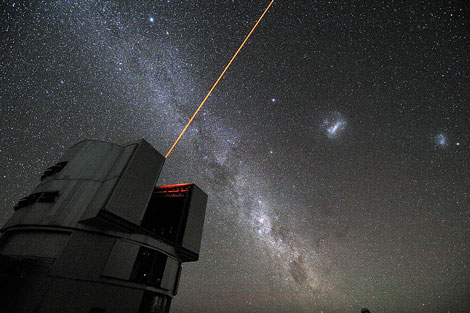Laser Beam Used to Observe Black Hole

Astronomers are boosting their efforts to peer deep into the center of the Milky Way in order to observe the massive black hole that resides there.
To get a clear and accurate picture of the black hole, astronomers are using the Laser Guide Star (LGS), a laser beam that corrects distorted images caused by the blurring effect of the Earth’s atmosphere.
The color of the laser beam is chosen to excite a band of sodium atoms found 56 miles up in the Earth’s atmosphere. These glowing atoms create an artificial star that is used as a reference point so that the observing telescope can calibrate itself.
Responsible for producing the LGS is the Very Large Telescope (VLT), which is operated by the European Southern Observatory (ESO.)
The VLT is made up of four separate optical telescopes (the Antu, Kueyen, Melipal, and Yepun telescopes) and are organized in an array formation.
Together the telescopes can achieve an angular resolution of 1 milliarcsecond, which means it could determine the gap between a car’s headlights on the Moon.
The VLT is located at the Paranal Observatory, which sits atop the Cerro Paranal, an 8,645 foot mountain in the Atacama Desert in northern Chile.
Check out what the telescope sees in just one night:
Image: G. Hüdepohl/ESO








